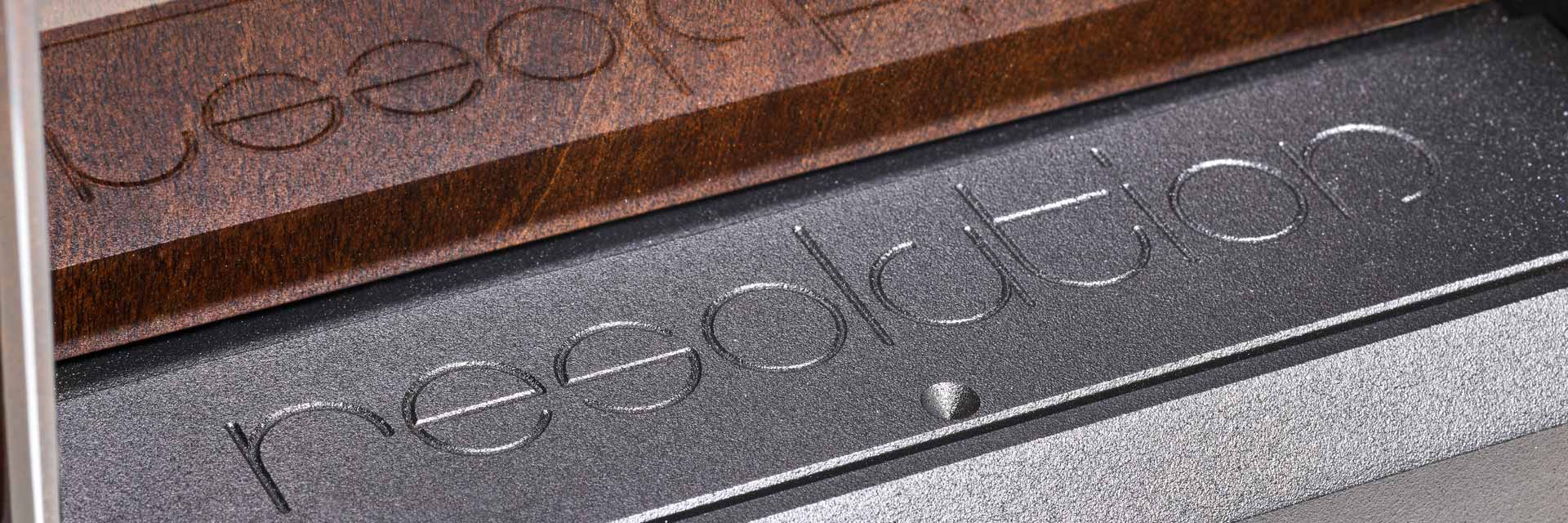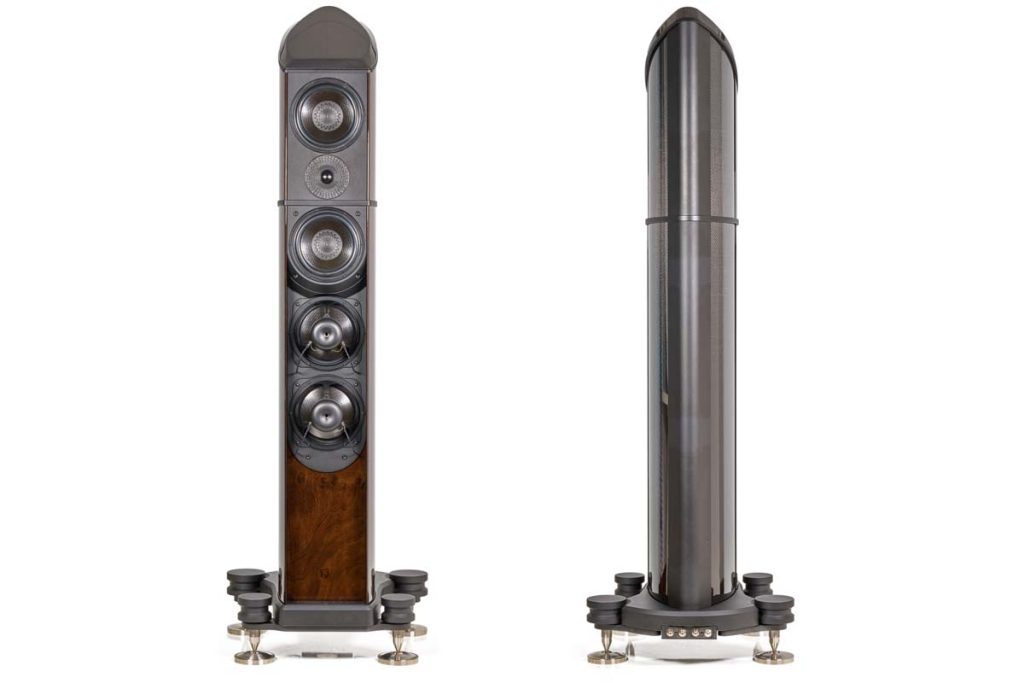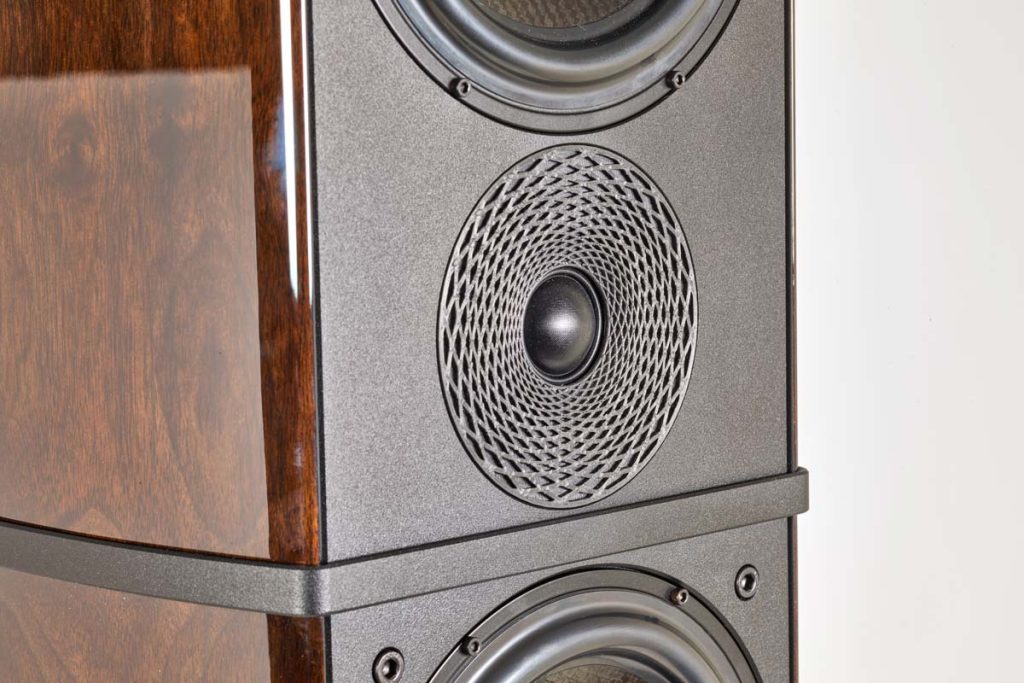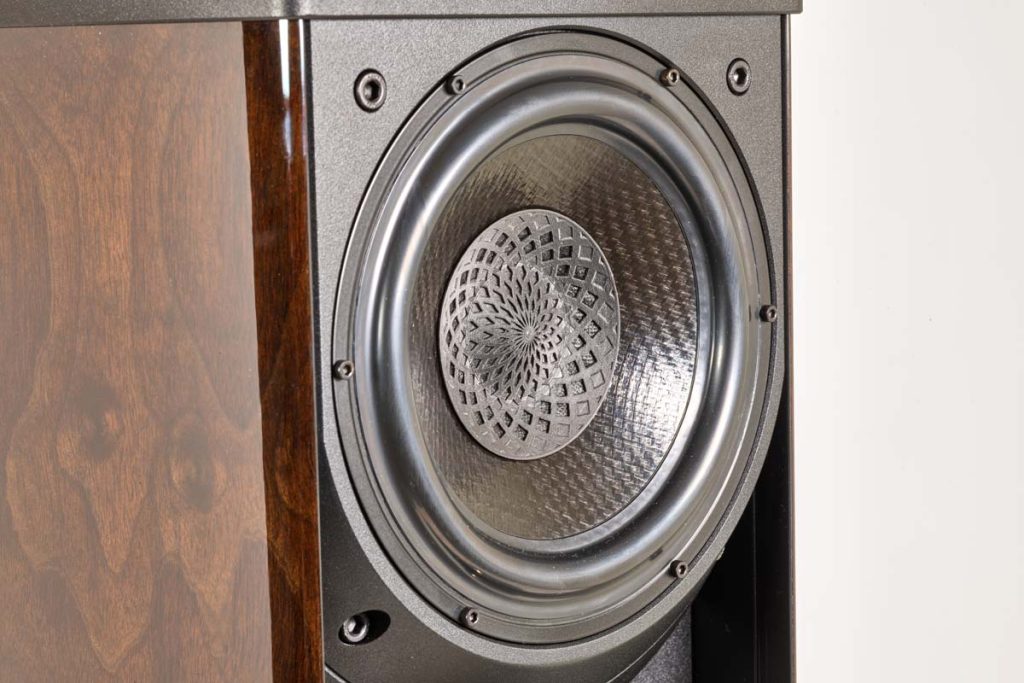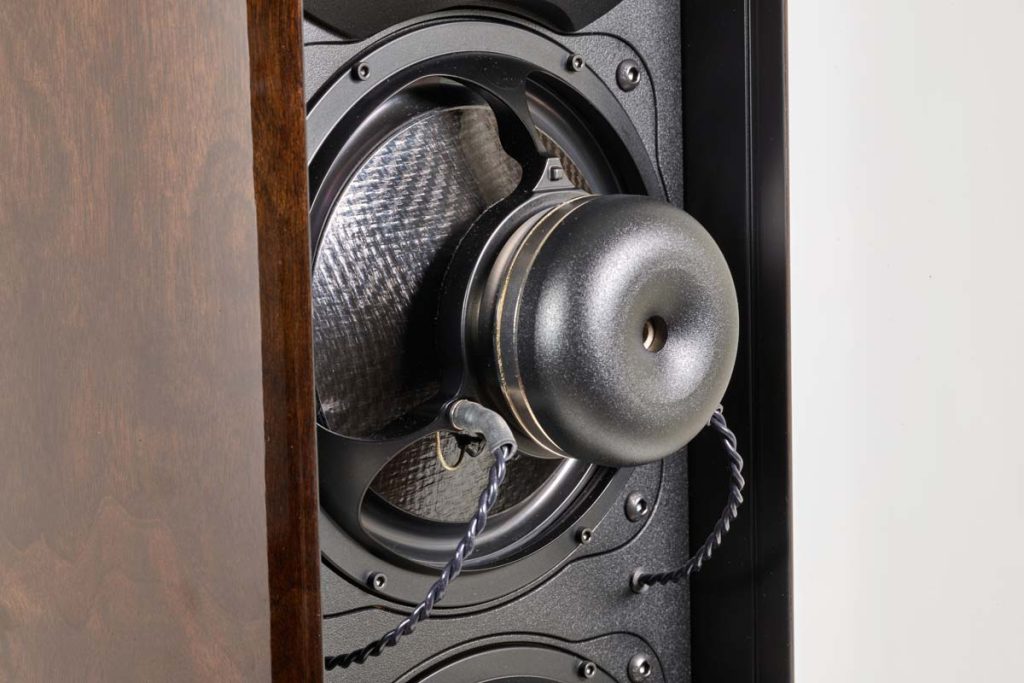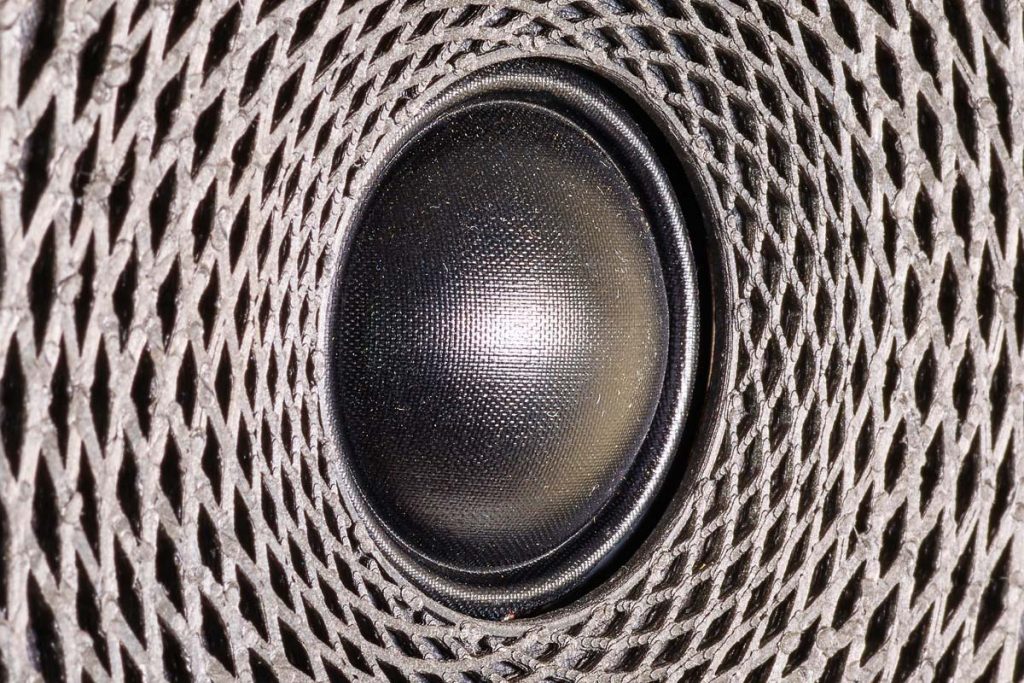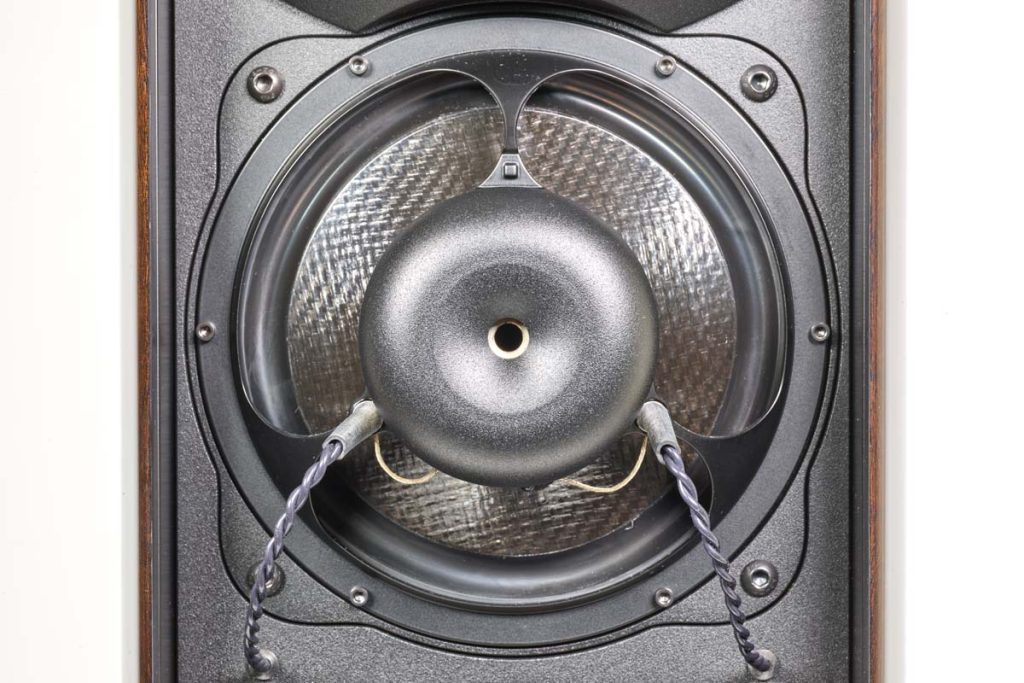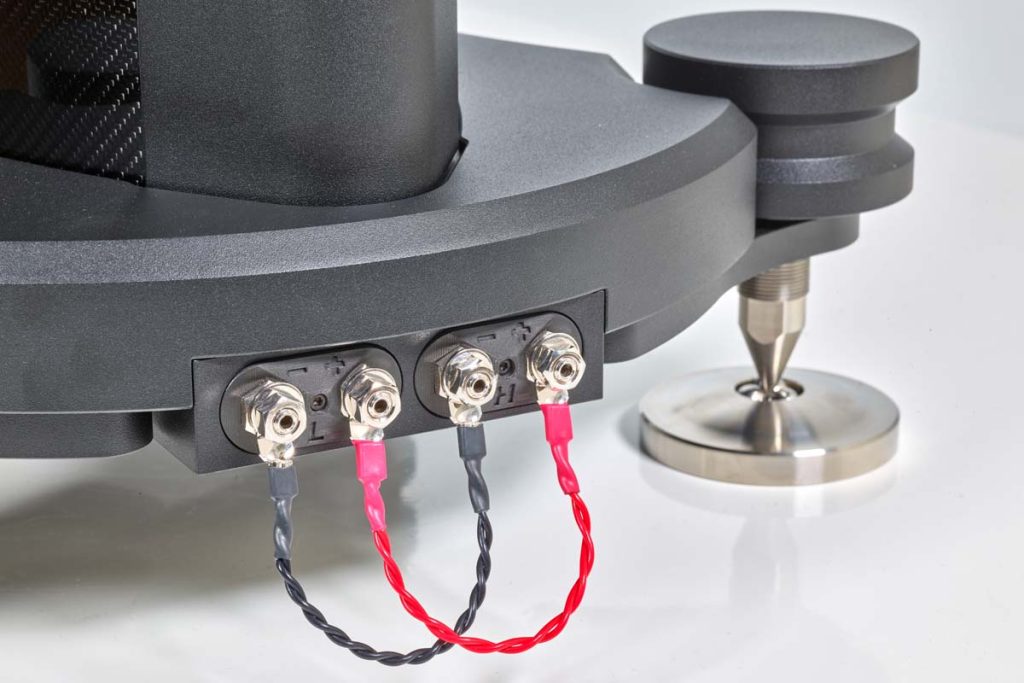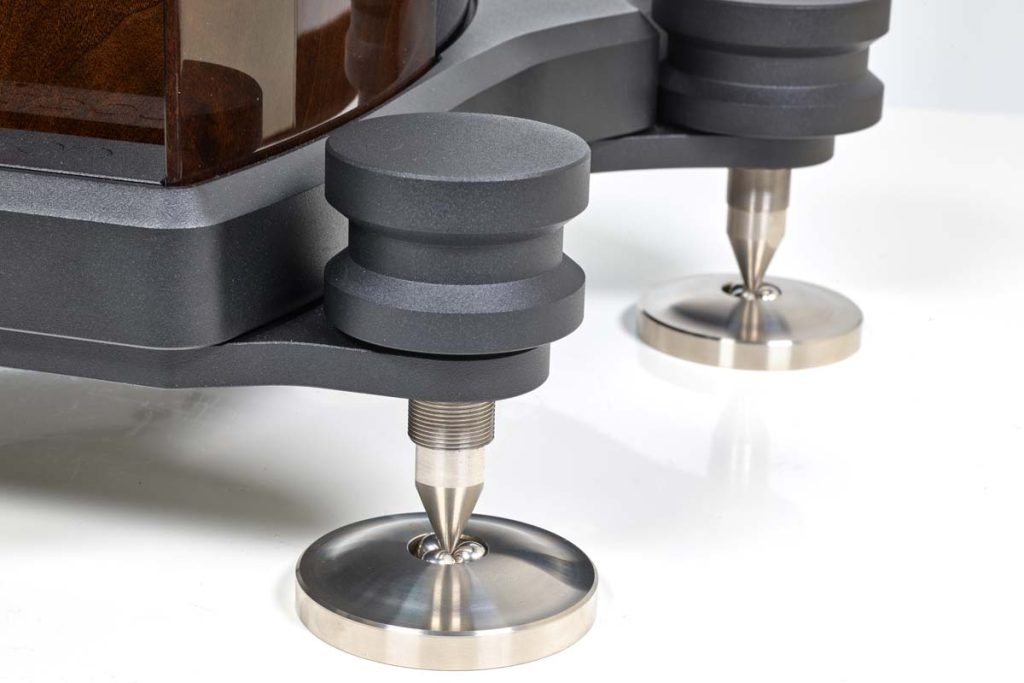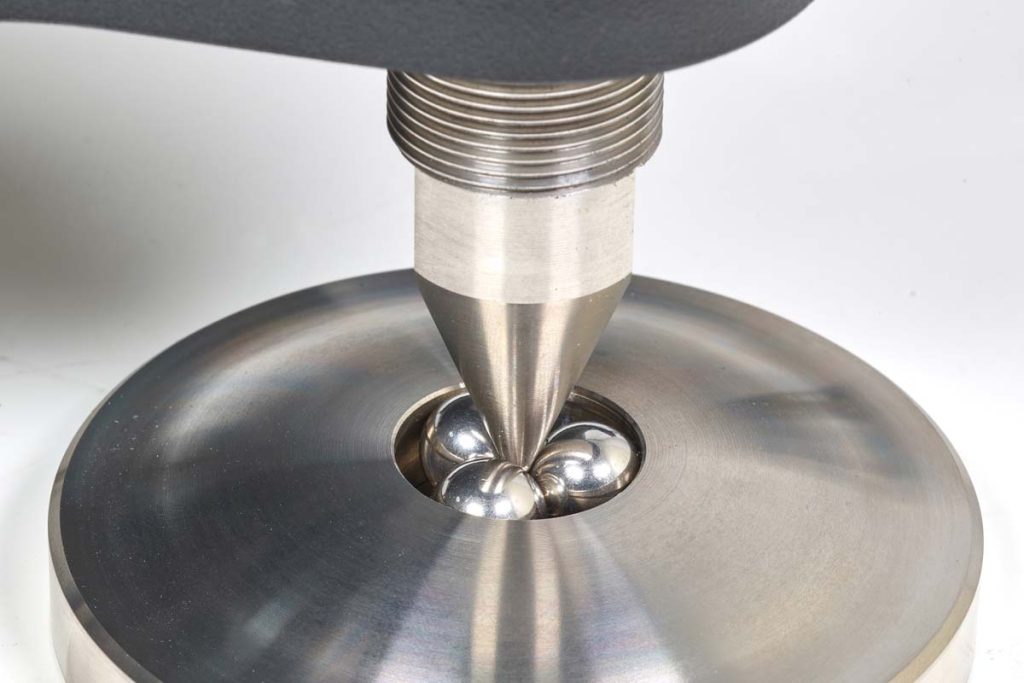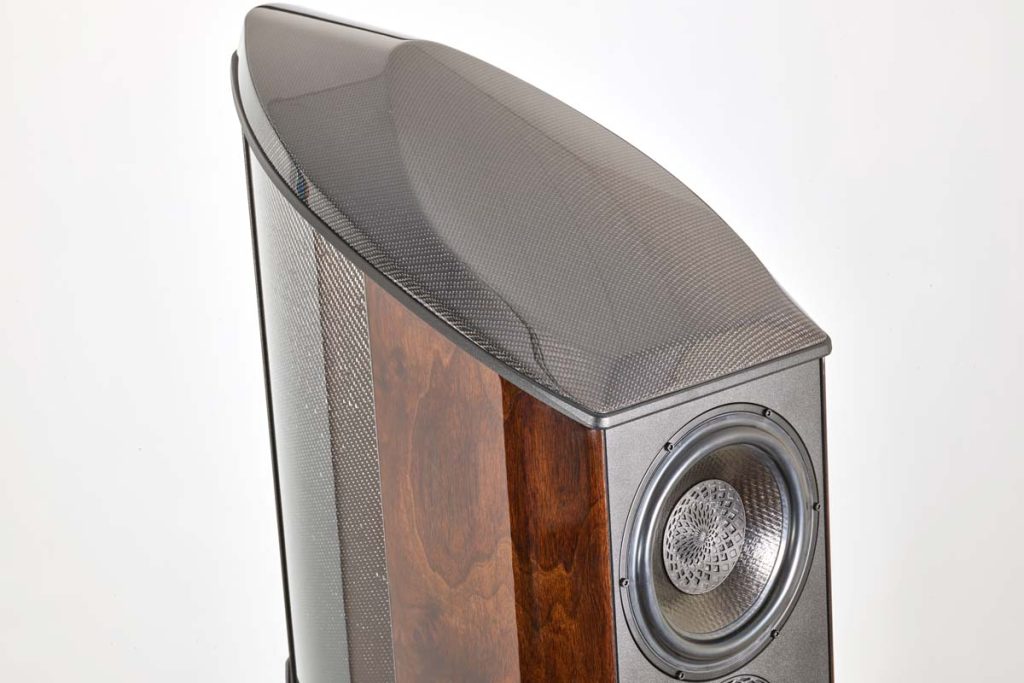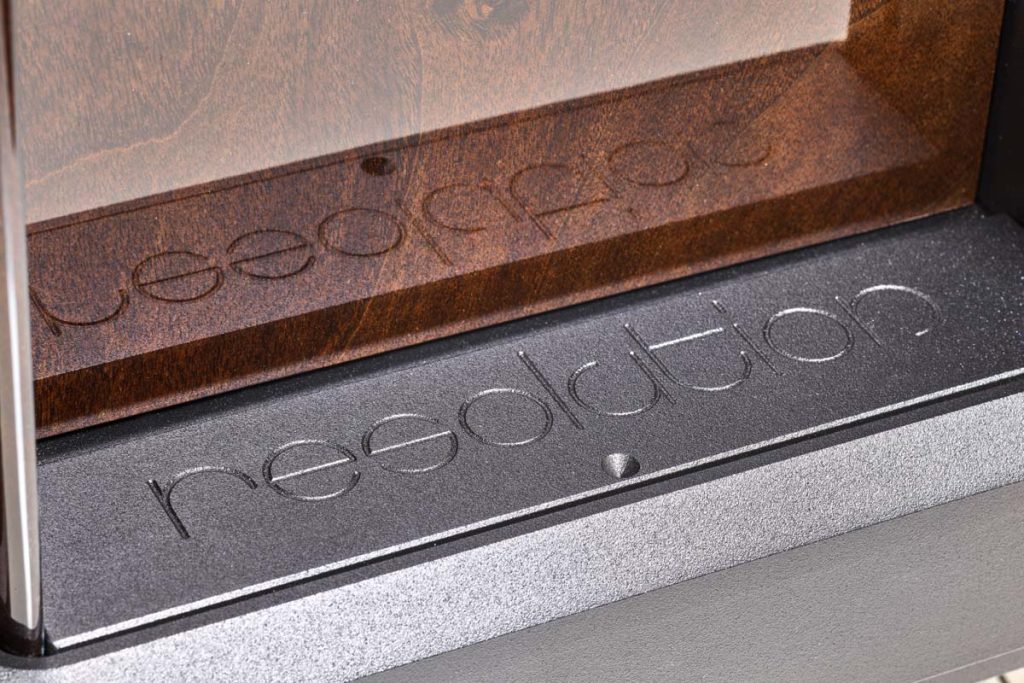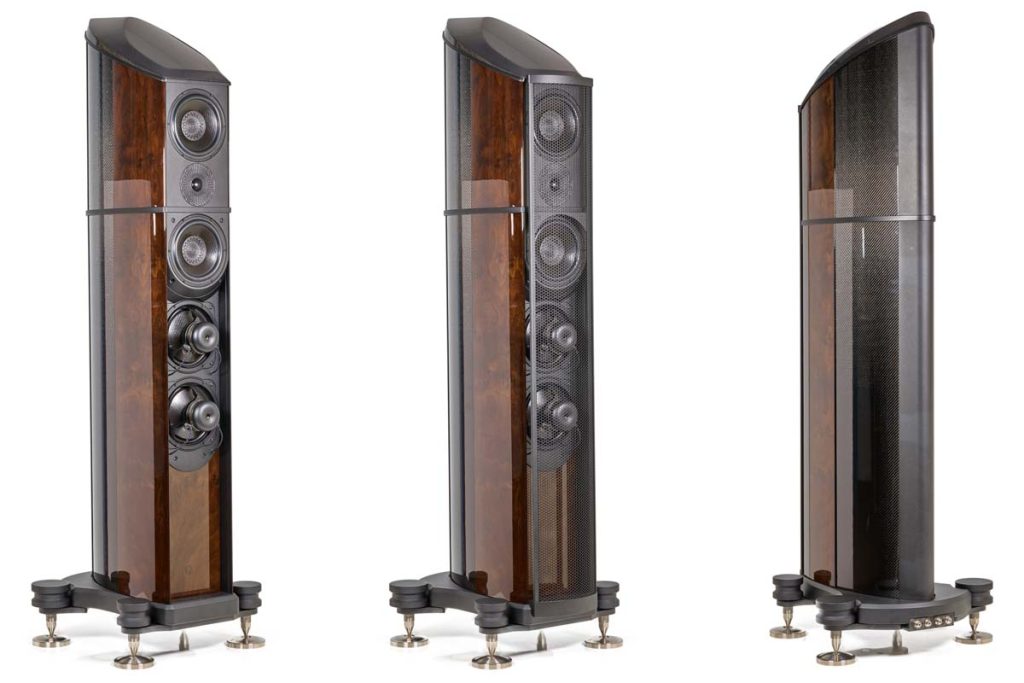How many days, weeks or months do you think it would take for a truly complete review of a speaker? For me, it strongly depends. But I can tell you with certainty how long it took for us to fall for Wilson Benesch’s luxurious Resolution 3Zero: 3 minutes.
When discussing Wilson Benesch, we really mean a brand that transcends labels and, like only a few others, distinguishes itself with unique concepts and an almost inconceivable number of special features. For example, after removing the solid metal cover of the larger models – the standard operating state for die-hard high-enders– the trained observer will immediately notice that the dimensions and arrangement of the tweeter’s grid-like surround are based on the Fibonacci sequence, the mathematical basis of the golden ratio. Alright, alright – you’ve been glued to the inverted bass drivers since removing the cover, so you may not have noticed the mathematical arrangement off the bat. By the way, the inverted drivers have nothing to do with the steamy atmosphere at the Wilson Benesch assembly halls. They are simply part of the isobaric bass concept in all Fibonacci models.
But to understand what makes this arrangement so logical and harmonious, let’s first explain a few universal aspects of speaker cabinets. They are fundamentally a good thing, as they give speakers style and provide ample surface for fine veneers or lacquers. Yet engineers are already frowning at this. For them, the cabinet’s principle role is shaping sound. If the cabinet is an open or closed design, with straight or rounded sides, then the drivers inside will work quite differently. The problem is that this involves an interdependent effect. The cabinet not only shapes the sound emission character, but also responds to what the drivers produce. When their diaphragms move, the pressure inside changes.
The speaker literally inflates, contracts, shakes and vibrates. Of course, this is particularly intense in the dynamic low bass. Therefore, if improperly constructed, then the large side walls in particular can become inadvertent diaphragms that toss sound around unchecked and diminish precision. This is why terms like “internal bracing”, “wall thickness”, “insulation” and “mass” are included in our speaker demonstrations. These are all proven to silence a loudspeaker cabinet.
But even better is the isobaric concept. The inverted Wilson Benesch basses are opposite the diaphragm of identical drivers, positioned invisibly inside the speaker. The manufacturer calls this arrangement “clamshell”, with the diaphragms facing each other. The pairs of drivers equalize the inner-speaker pressure through circuitry (“isobar” in Greek means “equal pressure”). This means that – apart from the movement of the featherweight, yet ultra-stiff diaphragms – nothing about a Resolution 3Zero (R3z) could upset the cabinet. And the Brits are armed with proven means to attack this final inconsistency: robust materials and sheer mass to add reinforcement and absorb vibrations.
But if it’s so brilliant, then why isn’t every manufacturer using the isobaric concept? For one thing, it naturally doubles the number of required bass drivers, and thus the cost. But to get at the actual problem, we need to take a step back …
Last spring we had the opportunity to meet Luke Milnes at an event in Rellingen. The son of Wilson Benesch founders Craig and Christina Milnes had come to present the latest generation of the Fibonacci family, including the R3z. We truly appreciated how the head of sales spoke so candidly and directly about the extensive evolution of the top models, as well as the sometimes daunting obstacles that were tackled along the way.
It started with the A.C.T.: once the undisputed heavyweight, today one of the smaller models in the British company’s top range. Despite its sound quality, many end users and dealers weren’t sufficiently impressed with the floorstanding speaker. Craig Milnes heard this demand for more power, and he began experimenting with larger cabinet dimensions and modified settings. That was over two decades ago. The chassis soon proved to be the eye of the needle: Milnes first tried with larger diameters, but their lower diaphragm stability and uncontrollable reverberation were hardly as precise as an A.C.T. He ended up with the ScanSpeak 8545, a comparatively modest seven inch speaker (17.5 cm), which he attempted in isobaric configuration – and the result was compelling.
But that was nearly the project’s end: The protruding ScanSpeak drivers looked terrible, and their molds, tweaked for stability, and huge magnetic drive obstructed the inverted sound dispersion. Milnes needed a more delicate driver with equal power. He discussed modifications with the Danes, but clearly the loudspeaker costs would explode with this small-scale production. Manufacturing the drivers himself suddenly looked appealing, but the company couldn’t afford the enormous development and tooling costs.
Let’s get to the underlying issue: There seems to be a natural barrier that prevents smaller manufacturers from fully implementing the isobaric principle in market-ready production loudspeakers. End of story!
But there was an unexpected twist for Wilson Benesch: Milnes mustered his entrepreneurial courage, applied for a government grant and launched a development that helps his company thrive to this day. In addition to the risky financing grant for the new drives, they gained a spot in the KTP program. In the early 2000s, the “Knowledge Transfer Partnership” program from the British government called on tech companies to work together and learn from each other. In addition to gaining valuable insight into current materials research and processing, Wilson Benesch made contacts with the research departments of several universities. These still generate vital dialogue and drive new impulses for development efforts. And this initially resulted in the Tactic drivers, used in flagship devices that have since been replaced, such as the Bishop and Chimera.
But let’s take a break here and look back at the events of late September last year. Krey Baumgartl from IAD sales couldn’t resist personally dropping off the R3z at the editorial office. That was a welcome gesture, since it takes all hands to move the two 98-pound columns. We hoisted the slim Resolutions out of their custom flight cases and moved them more or less into position. We also started up a combination of Luxman’s CL-1000 preamp, the M-10x stereo powerhouse and Lumin’s X1 – providing proper power for the fine transducers. Even though the R3z was put to work with many systems over the following weeks, the listening experiences in this article are based solely on the combination just described.
Once everything was temporarily set up, we dared a first test run – after all, you want to know if all the wires are properly strung. I began with the eponymous title track of Leonard Cohen’s You Want It Darker (via Qobuz) – and was stunned the very next moment. The first notes of snarling bass penetrated the room in volumes and as black as night. As usual, the poet’s voice projected into center stage sounding larger than life and vivid, announcing its message with resonance and delicate nuance. But what captivated me most was not its directness and attention to detail, nor the delightfully intense colors of the performance, but its breathtaking reproduction. The R3z delivered a rendition of the grand piano in Nick Cave’s “Idiot Prayer”, from the live album of the same name, that was almost intoxicating in its ease and composure. And the way it hoisted the various guitar solos in Black Sabbath’s “Warning” (Black Sabbath) from the listening room to the right and left, while sustaining Ozzy Osbourne’s voice as solid as a rock and even the most subtle modulation dead-center. Their ability to reproduce stages with the utmost vividness in virtually endless width and depth immediately ranked among the most impressive performances I’ve ever experienced. And let’s not forget that the 3Zeros hadn’t even been properly set up for this first impression.
The isobaric concept alone can hardly explain this captivating sound of the slightly more than shoulder-high columns (156 cm). Of course, if the cabinet doesn’t vibrate, then it doesn’t emit any unwanted acoustic noise. What can be heard in a proper listening room – almost exclusively direct sound, unpleasant coloring resonances, unwanted reflections and the resulting background noise – are significantly less than with other speakers. In fact, they are totally eliminated with the R3z. But ultimately the outstanding bass concept is only part of Wilson Benesch’s expertise. The continuously improved Tactic drivers (now in generation 3.0) were soon followed by the eponymous mathematics of the Fibonacci sequence. Its pattern is woven not only into the surround of the 25 millimeter silk dome tweeter, but also as diaphragm damping in the five 17 centimeter bass drivers and the midrange driver. Furthermore, it’s the basis for calculating various cabinet dimensions as well as for the sound-absorbing “labyrinths” behind the tweeter and midrange driver.
Incidentally, the manufacturer themselves make all of these components in the UK. In addition to custom chassis production, various 3D printing processes are used. Early on, Wilson Benesch became interested in the potential opened up by this new technology. The Brits are now one of the few manufacturers in the industry that can even produce metal components with 3D printing. In turn, we were able to admire samples of parts and an experimental tone arm during Luke Milne’s remarks. It’s actually a logical and consistent next step, since Wilson Benesch has always been a leader in utilizing innovative materials – especially carbon.
The R3z housing represents the next (and so far last) evolutionary step. Through many years of research – including another technology exchange called “SSUCHY” – the Brits perfected the proven monocoque construction of their heavyweight units. The body of the R3z is essentially made from a solitary component that is also manufactured directly on-site. The latest generation of the material, composed of several layers, is based on renewable resources and is biodegradable –a condition of the SSUCHY grant. That said, it would be hard for me to call the R3z the first high-tech compostable speaker. So many speakers with wooden cabinets would loudly object. Besides, it’s surreal to imagine a handmade masterpiece like this in the compost bin …
Joking aside, the shatterproof monocoque construction has several major advantages. For example, it enables an entirely original level of vibration and force distribution within the loudspeaker. In computer simulations long before the first prototype was built, Wilson Benesch and its research partners predicted how the last remaining driver movements would affect the cabinet, as well as how they could be deflected or absorbed. To accomplish this, the entire speaker stands on an extremely solid precision-milled aluminum base, which accounts for quite a bit of the total speaker weight. Huge spikes can be attached to four extensions on the base plate, with threads so precise that you can adjust the terminal metal washers with one finger after set up. The spikes rest among three steel balls mounted in the included floor protectors. These sixteen set-up aids alone (eight spikes and eight coasters) are so hefty that carrying the accessory packet could be a job for two.
In addition, the gently curved sides of the R3z are clad in expansive panels. These not only help to quiet the cabinet, but more importantly are available in a range of beautiful finishes.
To achieve the highest fidelity, the manufacturer spent a great deal of time experimenting with its crossovers. I believe the speaker draws much of its emotionality and “goose bump” qualities from the unfiltered midrange driver. The premium driver is directly connected to the robust terminals without phase-altering components, and it’s only limited by inertia. The diaphragm is extremely light, as with all Tactic 3.0 drivers, therefore it reaches exceptional heights. Only at around five kHz is the baton passed to the tweeter (up to 30 kHz). Like their counterparts inside, the two outer bass drivers don’t utilize crossover elements, but instead are trimmed by a steep low-pass filter at 500 Hz. The upper low bass is controlled by a first order filter. And this extraordinary compilation is what allows the manufacturer to rightfully call its R3z an “electric 2-way and acoustic 4-way concept”. By the way, it seems obvious that such a sophisticated loudspeaker design shouldn’t have colliding bass, midrange and treble – so these are enclosed in separate housing volumes.
Although I hardly would have expected this given my first impressions, we managed to tease out noticeably more performance from the R3z over the weeks. But this isn’t true for the sound staging – it reached a tremendous level immediately and then stayed there. We elicited the most subtle personality nuances from the R3z, especially by delicately angling it in – but as is usually the case when it comes to these aspects, it’s not easily defined as “better” or “worse”. The high-resolution tweeter is a truly revelatory master, graciously handling subpar recordings when necessary. On a whim, I listened to Nirvana’s Nevermind and Pearl Jam’s Ten and was not at all impressed with the cutting guitar strings of the two 1991 alternative productions. Turning the speakers slightly outward took care of the kinks. As expected, the treble lost some of its edge and gave the initially slightly faded recordings a silkier, more refined and more audible quality. On the other hand, top-notch classical recordings, such as Orff’s Carmina Burana with the Berlin Philharmonic under Seiji Ozawa (1989), were best with the speakers directly facing the listening position. Not only did this improve the clarity, it also enhanced the broadband midrange precision.
Now, truth be told, at just under 100 kilos, the R3z is not a speaker you want to move twice a day. But it’s good to know that it can be customized enough to personal taste in terms of tonality as well as treble and midrange presence.
On the other hand, another experiment made almost no difference: We generally operate speakers of this size with an adequate wall distance. Once placed in the FIDELITY listening room, the R3z had approximately 150 centimeters open in each direction. I understand that this doesn’t always work, which is why we also tried them relatively close to the wall (about 50 cm distance) during testing. Surprisingly, their reproduction was superb here, too. The lack of cabinet reflections and the bass reflex port under the base give real-world practicality to the giants.
To summarize: In the Resolution 3Zero, Wilson Benesch combines technical sophistication, materials and manufacturing tolerances that would be more likely found in aerospace engineering. The speakers, developed and manufactured entirely in the UK, offer top-notch design and build quality. The sound is undisputed and flexible in the scope described. Terms such as “colorations” or “resonances” are foreign to the R3z. There is no question: This luxury comes at a price that others would pay for a handsome SUV in the driveway. But it rewards its owners with an unfailing certainty: The sound ladder goes no higher than this. Not even with its two larger siblings. They are technically identical, but have more isobaric bass in one (Omnium) or two pairs (Eminence) which makes them more suited for larger rooms. But the magnificent siblings truly share the crown of sound.
Accompanying equipment
CD player: Audio Note CD 3.1x/II, Ayon CD-3sx | Network player/DAC: Lumin X1, X-odos Xo|stream pro | Integrated amplifiers: Aavik I-580, Trigon Exxceed | Preamplifiers: Luxman CL-1000, AVM Ovation SA 8.3 | Power amplifiers: Luxman M-10x, AVM Ovation MA 8.3 | Loudspeakers: Wilson Audio Sasha DAW, Børresen Z5 Cryo, DALI Epicon 6 | Rack: Finite Elemente, Solidsteel
Floorstanding Loudspeaker
Wilson Benesch Resolution 3Zero
Concept: Floorstanding speaker with monocoque cabinet and isobaric bass concept | Equipment: 25 mm hybrid silk/carbon tweeter (Wilson Benesch Fibonacci), 170 mm midrange driver (Wilson Benesch Tactic 3.0), 170 mm bass driver (Wilson Benesch Tactic 3.0), isobaric drive system 4 x 170 mm (Wilson Benesch Tactic in clamshell form) | Ways: Two-way electric, four-way acoustic | Impedance: 6 Ω nominal, 3 Ω minimum | Sensitivity (2.83 V): 90 dB@1 m on axis | Frequency response (±2 dB): 30 Hz to 30 kHz | Housing: Poly-Alloy, “A.C.T. 3zero” Monocoque, biocomposite enclosure with visco-elastic surfaces, 13 mm thick steel ties in the vertical axis | Standard finishes: Premium Black, wood (Burr Walnut, Ebonized Walnut, Walnut), special colors at additional cost: (Aventador Blue Aegir, Huracan Verde, Mugello Girgio Ferro, Senna Volcanic Orange, Senna Volcanic Red, Belladonna Phantom Purple), Carbon color at additional cost: (Enzo Red, Ettore Blue, Silverstone Silver) | Dimensions (W/H/D): 52/156/51 cm (with foot) | Weight: 98 kg | Warranty period: Five years | Price for pair: from €65,000
IAD GmbH
Johann-Georg-Halske-Straße 11
41352 Korschenbroich
Phone +49 2161 617830
service@iad-gmbh.de

